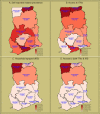Impact of insecticide-treated nets and indoor residual spraying on self-reported malaria prevalence among women of reproductive age in Ghana: implication for malaria control and elimination
- PMID: 35413832
- PMCID: PMC9003985
- DOI: 10.1186/s12936-022-04136-3
Impact of insecticide-treated nets and indoor residual spraying on self-reported malaria prevalence among women of reproductive age in Ghana: implication for malaria control and elimination
Abstract
Background: The Global Fund alone contributed 56% of all international financing for malaria and has invested more than US$13.5 billion in malaria treatment, prevention, and control programmes by June 2021. These investments include interventions such as mosquito nets, indoor residual spraying, and preventive treatment for children and pregnant women. However, there is paucity of studies for assessment of such investments to a reduction in malaria prevalence. This study was aimed at quantifying the impact of household access to insecticide-treated nets (ITNs) and the indoor residual spraying (IRS) on self-reported malaria prevalence among women of reproductive age in Ghana.
Methods: The study analysed the 2016 Ghana Malaria Indicator Survey (MIS) data. The MIS is a nationwide survey that included women aged 15-49 years. Poisson regression model with inverse probability to treatment weighting was used to determine average treatment effect estimate of the two malaria interventions on self-reported malaria prevalence among women of reproductive age in Ghana.
Results: A total sample of 4861 women interviewed from the 2016 Ghana MIS was used for analysis. The prevalence of self-reported malaria in 2016 was 34.4% (95% CI [32.4%, 36.4%]). Approximately 80.0% of women lived in households with access to ITNs [Percentage (Pr) = 79.9%, (95% CI [78.0%, 81.7%])], 12.4% (95% CI [7.5%, 19.8%]) of the households had access to IRS and 11.4% (95% CI [7.0%, 18.0%]) of the households had access to both ITNs and IRS. Household access to only ITN contributed to 7.1 percentage point (pt) reduction in the self-reported malaria among women (95% CI [- 12.0%, - 2.1%], p = 0.005) whilst IRS at the households contributed to 6.8pt reduction in malaria prevalence (95% CI [- 12.0%, - 2.1%], p = 0.005). Households with access to both ITNs and IRS contributed to a 27.1pt reduction in self-reported malaria prevalence among women (95% CI [- 12.0%, - 2.1%], p = 0.005).
Conclusion: Access to both ITNs and application of IRS at the household level contributed to a significant reduction in self-reported malaria prevalence among women of reproductive age in Ghana. This finding confirms the need for integration of malaria control interventions to facilitate attainment of malaria elimination in Ghana.
© 2022. The Author(s).
Conflict of interest statement
The authors declare that they have no competing interests.
Figures




References
-
- WHO. World Malaria Report 2019. Geneva, World Health Organization. 2019. https://www.who.int/publications-detail/world-malaria-report-2019. Accessed 2 Mar 2021.
-
- WHO . Malaria report 2018. Geneva: World Health Organization; 2018.
-
- WHO . Mission vision immunization vaccines 2015–2030. Geneva: World Health Organization; 2015.
-
- USAID. President’s malaria initiative. President’s malaria initiative—Ghana country profile. Ghana malaria operational plan FY 2018. 2018. p. 1–2. https://www.pmi.gov/docs/default-source/default-document-library/country.... Accessed 2 Mar 2021.
MeSH terms
Substances
LinkOut - more resources
Full Text Sources
Medical
Research Materials

